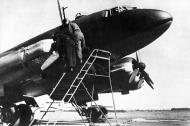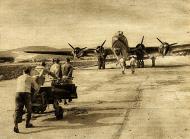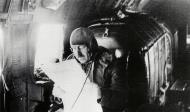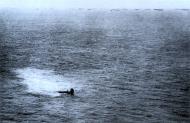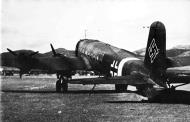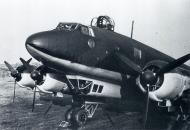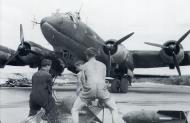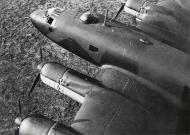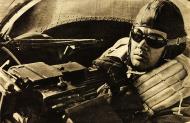Focke-Wulf Fw 200 Condor mixed photo's
Focke-Wulf Fw 200C Condor 9./KG40 crash-landed Spain 1943 01-02
Photo 01-02: On 13 August 1943 Fw 200C-5/U1, WNr. 0221 of 9./KG 40 was damaged in combat with a B-24 Liberator of the 1st Squadron/480th Anti-Submarine Group (captained by Lt F W McKinnon) and force-landed at Camarinas in Spain. Oblt Gunther Seide and his crew were quickly repatriated. Note the shadow of the Liberator on the ground in the picture above, clearly showing its belly-mounted AN/APS 15 search radar.
Such successes were few and far between as Uffz Werner Zerrahn of 9./KG 40 recalls:
"13 August 1943: In almost all cases, we had been briefed to fly an armed reconnaissance sortie over the Bay of Biscay as far as to the Azores. Flights like this had a duration of about 10 - 12 hours and our aircraft carried four 250 kg bombs and later two Henschel Hs 293A radio controlled missiles.
During our approach, we were able to make out a convoy and reported its position to Bordeaux by sending a coded radio message. Only a few minutes later, a B-24 Liberator appeared which caused a lot of trouble. The enemy's speed was considerably higher than ours and we received many hits. Our gunner Obgefr Heinz Wagner was wounded and holes in the fuel tanks caused the loss of quite an amount of fuel. Fortunately, we reached a layer of cloud and with the last drop of fuel we were able to make a good belly-landing in a harvested field of maize near La Coruna in Spain. After spending a few days in La Coruna and Valladolid, we came to Madrid and two weeks later, we arrived back at Bordeaux."
Focke-Wulf Fw 200C Condor attacking Allied Merchant Shipping 01-02
Photo’s 01-02: These two pictures show various Merchant shipping being attacked by unknown Fw 200C Condor’s.
Focke-Wulf Fw 200C Condor being serviced 01
Photo 01: An early Fw 200C1 or a C2 under construction. The distinguishing feature is the earlier style engine cowlings which contained the BMW 132H radial engine rated at 830 hp at 1100 metres. The C-l model introduced the ventral gondola offset to starboard on the Condor, which became such a common feature on all subsequent models.
Focke-Wulf Fw 200C Condor being serviced 02
Photo 02: An interesting comparison to the photograph at the top of the page, this picture shows an Fw 200C-3/U2 undergoing heavy maintenance, the later style stream-lined cowlings housing the BMW-Bramo 323R-2 Fafnir nine-cylinder radial engines being most apparent. Note the access hatches open in the nose and gondola.
Focke-Wulf Fw 200C Condor crew compartment 01
Photo 01: A scene inside the port fuselage of an Fw-200 during an over-water mission. Note the large 300 ltr fuel tank, one of five such tanks that could be installed in the fuselage for extended long-range missions. These unprotected tanks presented a major fire hazard, and made the aircraft vulnerable to return fire from ships or fighter aircraft. The aircrew member is seated in the second radio operator's take-off seat, he has his earphones plugged into the aircraft's communications system while studying map co-ordinates.
Focke-Wulf Fw 200C Condor forward HDL 151 turret 01
Photo 01: A very clean Fw 200C-3 or early C-4 Condor awaits its armament which has probably been removed for stripping and cleaning between operations. Note the positions of the four propellers - undoubtedly the ground crew took pride in the appearance of their aircraft.
Focke-Wulf Fw 200C Condor forward gondola 01
Photo 02:
Focke-Wulf Fw 200C Condor on patrol Bay of Biscay 01-02
Photo’s 01-02: These two pictures show the same image but with varying clarity of Fw 200C Condor escorted by Ju-88 on patrol over the Bay of Biscay.
Focke-Wulf Fw 200C Condor overhead view 01
Photo 01: Excellent detail is given in this overhead view of an Fw 200 C-3 Condor. Of interest is the canopy, showing escape hatches, internal overhead (folded) blinds and sliding windows. Aft of the cockpit is the low drag Fw 19 dorsal gun turret minus its 7.9-mm MG 15 machine gun. The small three pronged erection just forward of the turret is a blast guard (to prevent the machine gun from firing into the cockpit). The wording 'Nur hier betreten' on the port irmer wing walk-way means 'Only walk here'. Note the five circular fuel filler points for the five internal fuselage tanks atop the fuselage adjacent to the teardrop shaped blister, which is one of two vents to clear the fuselage of fuel vapor.
Focke-Wulf Fw 200C Condor top gondola 01
Photo 01: Detail photograph of a low-drag Fw 19 hydraulically-operated turret with a single 7.9 mm. MG 15 machine gun in the A-Stand on an Fw 200 C-3. At the bottom of the picture can be seen a portion of the curved tubing forming part of the blast guard to prevent the machine gun from firing into the cockpit.
Focke-Wulf Fw 200C Condor ventral gondola 01
Photo 01: This Fw 200C-3 or early C-4, features the improved armament introduced on these models - notably the forward dorsal hydraulically-operated HDL 151 turret housing a single 15 mm M G 151 canon and another with a 300-round belt in the nose of the early style ventral gondola.
Focke-Wulf Fw 200C Condor KG40 being refueled 01
Photo 01: A KG 40 Fw 200 C-3 Condor receives fuel prior to its next mission.
Focke-Wulf Fw 200C Condor KG40 being serviced 01
Photo 01: A Focke-Wulf Fw-200 Condor of I./KG 40 in the process of being serviced in either France or Norway in 1940/41. Note the feathered propeller, lack of armament in the ventral gondola, removed for servicing, and the red oxide primer applied roughly to panel joints under the nose.
Focke-Wulf Fw 200C Condor KG40 being serviced 02
Photo 02: A Focke-Wulf Fw-200 Condor of I./KG 40 undergoing maintenance and engine checks.
Focke-Wulf Fw 200C Condor KG40 being serviced 03
Photo 03: Major Edgar Petersen acquired the first Condors for his specialist long range anti-shipping unit later to be known as l./KG 40.This example undergoing a tail wheel change has the early type Balkenkreuz with the aircraft's individual letter 'B' painted in red and outlined in white.
Focke-Wulf Fw 200C Condor KG40 being serviced 04
Photo 04: An Fw 200C3 of KG40 undergoing maintenance on the ramp. The C-3 embodied major strengthening to the main spar and fuselage in an attempt to curb the structural failures. This model also saw the introduction of the low drag Fw 19 hydraulically-operated forward dorsal turret with a single 7.9 mm machine gun.
Focke-Wulf Fw 200C Condor KG40 Bordeaux 1943 01
Photo 01: Focke-Wulf Fw 200C3 Condor seen in the background just prior to its mission. It’s crew members using a pair of dividers to determine how long it will take them to reach their target. As the other crew members warm up the engines before climbing on aboard. Flights where often very long and tedious even with or without some excitement on the way.
Focke-Wulf Fw 200C Condor KG40 crew entry door 01
Photo 01: The crew entry door on a 7./KG 40 Condor betrays its airliner origins.
Focke-Wulf Fw 200C Condor KG40 crews 01-05
Photo’s 01-05: This series of colour photographs was taken for propaganda purposes and was published in a wartime book on the Luftwaffe called 'Fliegende Front'. The photographs show Fw-200 aircraft and crews of KG 40 based at Bordeaux-Merignac in the summer of 1941.All the aircraft have had their 'World in a Ring' unit emblems painted out, probably as part of a censorship precaution. In the photograph a crew receives its briefing, whilst Photo 02 crew members don three variations of flying helmet, the summer-weight LKp S 101, winter-weight LKp W 100 (or LKp W 101) and the lightweight summer version, LKp N 101. All wear the same K So/34 one-piece cotton flying suit with the SWp 734 10-30 Schwimmweste (life vest) and note how some crew wear their flying suits over their fleece-lined boots. Also visible lying on the ground around the crew are fuel hoses. Photo 03 shows the nose gunners position.
Focke-Wulf Fw 200C Condor KG40 emblem 01
Photo 01: Close-up of KG 40's famous 'world in a ring' emblem, reflecting the nature of its long-range maritime operations. When reproduced on either side of the aircraft it was 'handed' so that the ring pointed down and forward. The emblem was in continuous use until very late in the war.
Focke-Wulf Fw 200C Condor KG40 engine maintenance 01
Photo 01: A Focke-Wulf Fw 200C3 Condor undergoing engine maintenance on its four BMW-Bramo 323R-2 Fafnir nine-cylinder radial engines at Bordeaux-Merignac. Rated at 1,000 hp at sea level and 1,200 hp at take-off with the aid of methanol-water injection, the C-3 model offered much improved performance over previous sub-types.
Focke-Wulf Fw 200C Condor KG40 forward HDL 151 turret 01
The forward fuselage of a Fw 200C-4 Condor shows the distinguishing features of this much-produced model: namely the upper dorsal hydraulically operated HDL 151 turret housing a single 15-mm MG 151 cannon with a 500-round belt with a spare 300-round belt. Although the increase in fire power was appreciated, it did come with a penalty, notably a reduction in top speed by 26-29 k/ph (not all C-4s were fitted with this turret - some reverted to the earlier Fw 19 type). The other distinguishing feature is the Lotfe 7D bombsight, which considerably improved the Condor's bombing accuracy. Also of note is the redesigned and more streamlined glazing in the ventral gondola first seen in some C-3 Condors.
Focke-Wulf Fw 200C Condor KG40 loading SC-250 bombs 01-02
Photo’s 01-04: These two pictures show the preparation of loading by use of a hydraulic jack some SC 250 bombs outboard of the engines of a Fw 200 Condor of KG 40. Note the use of wooden blocks under the bomb on the hydraulic jack to enable the bomb to be attached to the shackles in these outboard positions. Note also the high racking Luftwaffe officer watching the loading process in the photograph to the right.
Focke-Wulf Fw 200C Condor KG40 Norway 01
Photo 01: An alternative to pre-heating the engines prior to starting in cold conditions was to position the aircraft beneath a specially constructed temporary building. Apart from assisting maintenance in cold weather, this building also enabled the work to be carried out with a degree of comfort both by day and night. This Fw 200 belonged to KG 40 based in Norway.
Focke-Wulf Fw 200C Condor KG40 waist position 01
Photo 01: Gunner's view from the starboard waist position of a Fw-200 Condor on patrol low over the sea. Note the saddle magazine for the 7.9 mm MG 15 machine gun.
KG40 attack British convoy 1941 01
Photo 01: A photograph taken from a Fw-200 Condor of I./KG 40 in October 1941 of a British convoy. By the time this photograph was taken, offensive operations by the Condor had to be restricted to shadowing convoys etc. due to the increasing numbers of merchant ships being equipped with anti-aircraft guns, in the summer of 1941 and the introduction of catapult merchant ships (CAM) by the Royal Navy. This latter development involved a Hurricane being catapulted from the forward bows of the merchant ship when the enemy aircraft was sighted. Its major drawback was the fact that the Hurricane had to be ditched in the sea alongside an Allied vessel in order for the pilot to be hopefully - picked up after the engagement. Nevertheless the Condors suffered with the first loss to the CAM ships on 3 August 1941 when an aircraft of l./KG 40 was shot down by Lt. Everett flying from HMS Maplin.
KG40 attack on MS Starstone W Donegal 1940 01
Photo 01: The 5,702 tonne merchant ship 'Starstone' lies damaged and burning west of Donegal on 31 October 1940 after being attacked by a lone Fw 200 of l./KG 40 flown by an unidentified Feldwebel.
KG40 attack and sinking of MS Tunisia 1941 01-02
Photo’s 01-02: Two views of what is believed to be the merchant vessel 'Tunisia' under attack and eventually sunk by Focke-Wulf Fw-200 Condors of KG 40 on 4 August 1941.
Luftwaffe Bomber Units in the West, 16 August 1941
| Luftwaffe Unit | Aircraft | Commander | Based | A/C No. | A/C No. |
|---|---|---|---|---|---|
| Luftflotte 3 | General der Flieger Hugo Sperrle | Paris | |||
| II. Gruppe/KG 2 | Do 17 Z, Do 217 E | Major Johannes Hubner | Evreux | 18 | -8 |
| Stab/KG 30 | Ju 88 A, He 111 H | Major Erich Bloedorn | Evreux | 2 | -2 |
| I. Gruppe/KG 30 | Ju 88 A | Hptm. Lau | St. Andre (to Stavanger later in the month) | 33 | -16 |
| III. Gruppe/KG 30 | Ju 88 A | Major Schumann | Gilze-Rijen | 34 | -20 |
| Fliegerfiihrer Atlantik | Gen.Maj Martin Harlinghausen | Lorient | |||
| I. Gruppe/KG 40 | Fw 200 | Hptm. Edmund Daser | Bordeaux-Merignac | 28 | -10 |
| II. Gruppe/KG 40 | Do 217 E | Hptm. Wendt Freiherr von Schlippenbach | Cognac (less 4.Staffel) | 24 | -3 |
| III. Gruppe/KG 40 | He 111 H | Hptm. Robert Kowalewski | Bordeaux-Merignac | 20 | -6 |
| KGr106 | Ju 88 A | Major Friedrich Schallmeyer | Amsterdam-Schipol | 14 | -6 |
| 2. Staffel/KGr 506 | Ju 88 A | (unknown) | Westerland | 9 | -4 |
| KGr606 | Ju 88 A | Obstlt. Joachim Hahn | Lannion | 20 | -8 |
| Luftflotte 5 | Generaloberst Hans Stumpff | Oslo | |||
| IV.Fliegerkorps | Generalleutnant Kurt Pflugbeil | Beauvais | |||
| I. Gruppe/KG 30 | Ju 88 A | Major Horst von Riesen | Banak (4. & 5./KG 30 only) | -16 | |
| Fliegerfiihrer Nord | Generalleutnant Alexander Holle | Stavanger | |||
| I. Gruppe/KG 26 | He 111 H | Major Hermann Busch | Aalborg West Stavanger-Sola | -18 | |
| 6. Staffel/KG 30 | Ju 88 A | (unknown) | Stavanger-Sola | -7 |
Fw 200 Condor
The Focke-Wulf Fw 200 Condor was the only four-engined, long-range aircraft in service with the Luftwaffe during WW II.
The aircraft was a simple development of a pre-war commercial craft. First flown in 1937 it was an all metal construction, four-engine monoplane capable of carrying 25 passengers up to 3000 km, it flew from Berlin to New York in twenty hours without stopping. To adapt it for wartime, hard-points were added on the wings for bombs, the fuselage was extended and strengthened to create more space and front, aft and dorsal gun positions were added. The extra weight of the improvements meant that a number of early Condors would break-up on landing, a problem that was never entirely fixed. Later models were equipped with radar.
The Luftwaffe initially used the aircraft in conjunction with the Kriegsmarine, making great loops out across the North Sea and (following the fall of France) the Atlantic Ocean, the aircraft undertook maritime patrols and reconnaissance, searching for Allied convoys and warships to be reported and targetted by U-boats. The Condor could also carry bombs or mines to be used against shipping and it was claimed that from June 1940 to February 1941 they sank 365,000 tons. From mid-1941 the aircraft were instructed to avoid attacking shipping and avoid all combat in order to preserve numbers, but the arrival of the new escort aircraft carriers was a very serious threat.
The Condor was also used as a transport aircraft, notably flying supplies into Stalingrad in 1943. After late 1943 the Condor came to be used solely as a transport aircraft. For reconnaissance it was replaced by the Junkers Ju 290 and as France was invaded maritime reconnaissance became impossible. Production ended in 1944 with a total of 276 aircraft produced.
Military Fw 200-C3 Specifications
Wing span: 33 m
Length: 23.8 m
Engines: 4 BMW Bramo 132H, 850 hp each
Max Speed: 384 km/hr (at 4000 m)
Ceiling: 5900 m
Range: 3550 km, 14 hours
Max weight: 24500 kg (fully loaded)
Crew: 5
Armament: 2 20 mm cannon, 4 13 mm machine gun; 1500 kg of bombs or mines.
Additional References:
History
The German Fw 200 Condor was initially a trans-Atlantic passenger and cargo (mail) aircraft developed by Focke-Wulf and legendary designer Kurt Tank in 1936. Early prototypes were fitted with the Pratt & Whitney Hornet radial piston engines generating 750hp each. Subsequent wartime powerplants reverted to native BMW-series radials including the BMW 132G-1 and the BMW 132H. The trans-Atlantic passenger models were equipped to carry 26 flyers in two separate cabins. Fw 200A passenger models were delivered to the airliner Lufthansa along with air carriers in Brazil and Denmark for evaluation for commercial purposes.
With the advent of war, the Fw 200 Condor series was utilized as a successful maritime reconnaissance bomber and VIP transport (Hitler and Himmler were both reported users of the Fw 200 for this purpose). Excelling in disruption of Allied shipping lanes throughout the Atlantic and the Arctic, the Fw 200 Condor was fitted with anti-shipping armaments including anti-ship mines. Later variants, the Fw 200C-6 and 200C-8 would be fitted with the Henschel Hs 293 anti-ship guided missile controlled by an integrated missile control radio onboard.
Early models featured accommodations for five crewmen whilst later ones saw that increased to seven. Armament was standard for the most part (with exceptions made on later models) and featured a variety of 7.92mm machine guns and 13mm guns along with a 20mm cannon. Internal bomb load capacity was roughly 4,600lbs. An engineering defect in the aft fuselage tail section (the structural shortcomings contributed to many accidents) kept the Condor from reaching the legendary status like that of the Battle of Britain veterans - the Dornier Do 17 and the Heinkel He 111 (both detailed elsewhere on this site). Thusly the system was relegated it to the supplementary roles mentioned above.
In the end, production totals are reported to have been between 250 and 275 total aircraft. The addition of the Hs 293 missile system was a step towards the more advanced guided variants we see in today's bombers. Nevertheless, and despite it's shortcomings, the Fw 200 Condor found its niche in the Second World War as a successful maritime reconnaissance aircraft for the Third Reich. Incidentaly, a C-series protoype was ordered by Japan but never delivered.
Focke-Wulf Fw 200 Condor
Specification (C-3/U4)
Type: long-range reconnaissance bomber
Powerplant: 4 x 1,200hp Bramo 323R 9-cylinder radial piston engines
Performance: 224mph / 360kph (maximum speed), 208mph / 335kph (cruising speed), 19,685ft / 6,000m (service ceiling), 2,212 miles / 3,560 km (maximum range)
Weight: 37,490lbs / 17,005kg (empty), 50,057lbs / 24,520kg (maximum take-off)
Dimensions: 107ft 9.25in / 32.85m (wing span), 76ft 11.25in / 23.45m (length), 20ft 8in / 6.30m (height), 1,290.10sq.ft / 119.85m.sq (wing area)
Armament: 4 x 13mm (0.51in) MG131 machineguns in dorsal and beam positions, either 1 x MG131 or 1 x 20mm MG151/20 cannon in a ventral gondola plus four 551lbs (250kg) bombs
Used: Germany.
History
While the British have always been famous for their ability to improvise, in the matter of anti-shipping aircraft, it was German that had to make do in World War II. Kurt Tank, the lead designer at Focke-Wulf, presented his ideas for a new transport aircraft for Deutsche Lufthansa to the Board of Directors of the airline on 16 July 1936, promising that the first examples would fly within a year. As it turned out, the Focke-Wulf Fw 200 V1 (later named Saarland), the first of three prototypes, first flew on 27 July 1937, only just missing the year deadline, still a highly commendable performance. An all-metal, low-wing monoplane, the Fw 200 was initially powered by four 875hp Pratt & Whitney Hornet radial engines and designed to accommodate up to twenty-six passengers in two cabins. The main wheel legs, which retracted forward into the engine nacelles, were of a rather unusual design, this being an attempt to produce an undercarriage, which, in the event of an emergency would extend with the aid of the slipstream.
Of the two further prototypes (named Westfalen and Immelmann III respectively), the third became Adolf Hitler's personal transport, were each powered by four 720hp BMW 132G-1 radials. The fourth prototype (named Saarland while the first prototype was renamed Brandenburg) and four examples of the initial production Fw 200A (Nordmark, Grenzmark, Friesland and Pommern) were delivered to Lufthansa, another two Fw 200A aircraft went to DDL Danish Air Lines (Dania and Jutlandia) and two more went to Lufthansa's Brazilian associate, Syndicato Condor (Arumani and Abaitara).
The first prototype (Brandenburg), was re-designated Fw 200S-1 and made a number of record flights in late 1938. These flights began on 10 August when Lufthansa's Alfred Henke flew non-stop from Berlin to New York in a time of twenty-four hours, fifty-six minutes and returned on 13 August in nineteen hours, fifty-five minutes. It also flew on 28 November setting a forty-six hour, eighteen minute record for the journey between Berlin (via Basra, Karachi and Hanoi) to Tokyo. A number of additional aircraft were supplied to Lufthansa before the outbreak of World War II and a surviving aircraft (a Fw 200B-2 D-ASHH) undertook the airline's last scheduled flight before the secession of hostilities between Barcelona and Berlin on 14 April 1945.
The prototype's flight to Tokyo resulted in an order for five Fw 200B airliners from Dai Nippon KK and a single maritime reconnaissance aircraft for the Imperial Japanese Navy. However, none of these aircraft were supplied to Japan but three of the airliners were completed under the designation of Fw 200B-2 and delivered instead to Lufthansa, equipped with 830hp BMW 132H radial engines. Lufthansa also received a single Fw 200B-1 with four 850hp BMW 132DC radials. The requirement from the IJN for a long-range reconnaissance aircraft led to the construction of the Fw 200 V10 military prototype that featured an increased fuel capacity and an armament of one 7.92mm (0.31in) MG15 machinegun in a dorsal turret as well as another two in the ventral gondola. There was initially almost no interest at all in this version of the aircraft but just before the outbreak of World War II the Luftwaffe decided to set up a long-range anti-shipping unit, with the Luftwaffe Chief of the Air Staff, General Hans Jeschonnek ordering Oberstleutnant Edgar Petersen, to form such a unit.
The only aircraft that was immediately available and possessed the requirements for such a task was the Condor but it was by no means the most satisfactory as its structure was too weak for military operations. The Fw 200 V10 was evaluated as a possible candidate and ten preproduction Fw 200C-0 aircraft (with a strengthened airframe) were ordered, being delivered in September 1939.
The first four were unarmed and these, along with Lufthansa's four Fw 200B aircraft equipped Kampfgeschwader zur besondern Verwendung (KGzbV – literally Battle (Bomber) Wing on Special Duties) 105 at Kiel-Holtenau in April 1940, taking part in the invasion of Norway. It was later re-designated 1. / KG40. After being transferred to Bordeaux-Mérignac the unit, now re-designated I / KG40 went into action against the British Isles, with Condors conducting experimental operations in mining the East Coast ports with 2,200lbs (1,000kg) mines.
The initial production reconnaissance version was the Fw 200C-1, armed with one 20mm MGFF cannon in the nose, one 7.92mm (0.31in) MG15 in the ventral gondola, as well as the rear and forward dorsal positions. Offensive armament included four 551lbs (250kg) bombs on under-wing racks and was equipped with 830hp BMW 132H engines. I / KG40 were re-equipped with this variant and during August and September 1940 sank over 90,000 tons of shipping.
On 26 October 1940, Oberleutnant Bernhard Jope bombed the 42,000 ton liner Empress of Britain, the ship later being sunk by a U-Boat. Between August 1940 and February 1941, the unit claimed over 343,000 tons of ships sunk. The Fw 200C-2 was generally similar and differed only in having the rear of the engine nacelles cut away and having streamlined bomb racks, allowing 551lbs (250kg) bombs or 66 Imp gal (300 litre) drop tanks to be carried.
The structural weakness of these two versions led to the improved Fw 200C-3 introduced in 1941. As well as a strengthen airframe, the aircraft featured the more powerful 1,000hp Bramo 323R-2 radial engines and various armament changes accounted for various sub-variants including the Fw 200C-3/U1 with an 15mm MG151 cannon in a power-operated forward turret and the nose-mounted MGFF cannon being replaced by an MG151. The Fw 200C-3/U2 had the MG151/20 deleted to allow the inclusion of a Lofte 7D bomb sight, while the C-3/U3 carried an MG131 in each of the front and rear dorsal positions and the C-3/U4 accommodated an extra gunner and two additional beam-mounted MG131s.
Despite the airframe strengthening, the weakness issue was never fully fixed and many Fw 200s became casualties when their backs broke on landing. In 1942, production of the Fw 200C-4 was started, essentially similar to the Fw 200C-3, this version carried FuG Rostock search radar (later FuG200 Hohentwiel equipment) and was armed with an MG151 cannon in the forward dorsal turret, an MG151/20 cannon in the nose of the ventral gondola (unless a Lofte 7D bomb sight was required when it was replaced by an MG131 machinegun and MG15s in the other firing positions. Single examples were built of the Fw 200C-4/U1 and Fw 200C-4/U2 high-speed transports, one of which became Heinrich Himmler's personal aircraft and had additional armour plate fitted. To provide an additional offensive capability, a number of Fw 200C-3/U1 and Fw 200C-3/U3 aircraft were modified, becoming the Fw 200C6 series to serve as interim missile carrier, being equipped with two under-wing Henschel Hs293A rocket-propelled guided bombs and FuG203b Kehl missile control equipment. These started to enter service in November 1943 with III/KG40.
A definitive version of the Fw 200C-6 was built in small numbers, being designated the Fw 200C-8 and added Hohentwiel radar to the onboard equipment, this being the final production version. No accurate production figures exist but it was never produced in huge numbers with around twenty-six Condors being delivered in 1940, fifty-eight in 1941, eighty-four in 1942, seventy-six in 1943 and eight in 1944, for a total of around 272 is being built and despite their small numbers, were the scourge of Allied shipping for much of the war before successful countermeasures were introduced, such as greater anti-aircraft defences and catapult aircraft. The Condor served until the end of the war but after 1942, was used more and more in the role for which it was originally built – that of a transport aircraft. Several Condors even saw service after the end of the war, for example, the Soviets captured a number of Fw 200s at Tempelhof airport at the end of the war and one, a civilian aircraft with the registration N-500 was used at the Svernyy Polyus-4 (North Pole 4) arctic research station in 1949. Another aircraft, registration N-401 was used at Igarka, Northern Siberia in 1947 while still another example, with the registration N-400, was used in the Soviet arctic regions for ice reconnaissance.
Book References: +
- Gunston, Bill. The Illustrated Encyclopedia of Combat Aircraft of World War II, Salamander Books, London, 1977.
- Kay, Anthony L and Smith, J R. German Aircraft of the Second World War, Putnam, London, 2002 (Rev Ed).
- Mondey, David. The Hamlyn Concise Guide to Axis Aircraft of World War II, Bounty Books, London, 2006.
Magazine References: +
- Airfix Magazines (English) - http://www.airfix.com/
- Avions (French) - http://www.aerostories.org/~aerobiblio/rubrique10.html
- FlyPast (English) - http://www.flypast.com/
- Flugzeug Publikations GmbH (German) - http://vdmedien.com/flugzeug-publikations-gmbh-hersteller_verlag-vdm-heinz-nickel-33.html
- Flugzeug Classic (German) - http://www.flugzeugclassic.de/
- Klassiker (German) - http://shop.flugrevue.de/abo/klassiker-der-luftfahrt
- Le Fana de L'Aviation (French) - http://boutique.editions-lariviere.fr/site/abonnement-le-fana-de-l-aviation-626-4-6.html
- Le Fana de L'Aviation (French) - http://www.pdfmagazines.org/tags/Le+Fana+De+L+Aviation/
- Osprey (English) - http://www.ospreypublishing.com/
- Revi Magazines (Czech) - http://www.revi.cz/
Web References: +
- Wikipedia.org - http://en.wikipedia.org/wiki/Heinkel_He_219
 Editor for Asisbiz: Matthew Laird Acred
Send Mail
Editor for Asisbiz: Matthew Laird Acred
Send Mail
Please help us to improve these articles with any additional information or photo's.
If you should encounter any bugs broken links, or display errors just email us.
If you love our website please add a like on facebook or follow us on Google+
Please donate so we can make this site even better !!

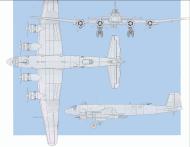

-Werknr-0126-taking-off-Kolberg-01.jpg)

